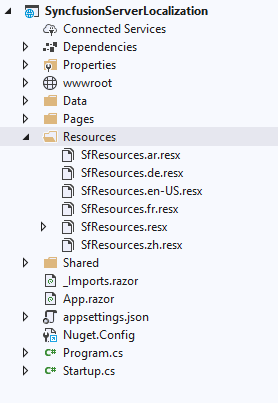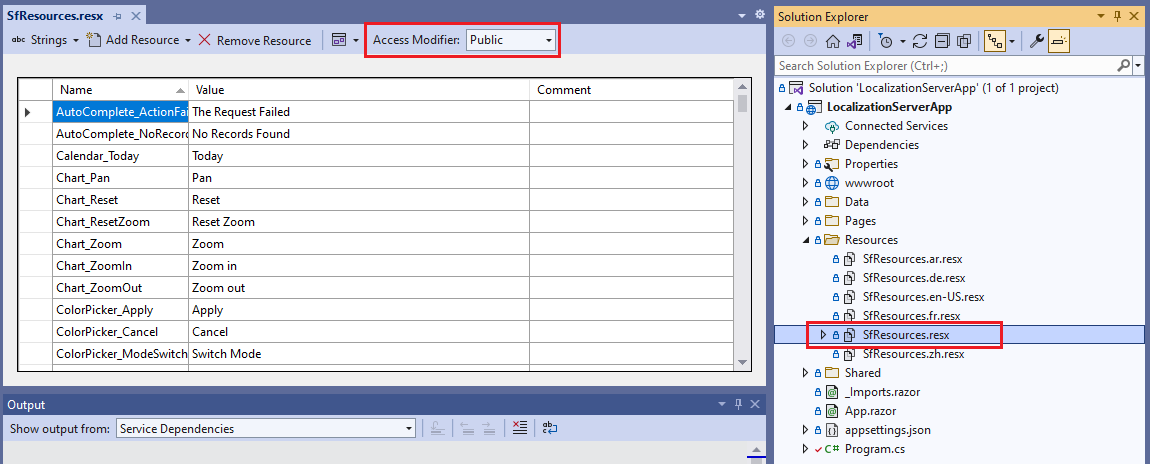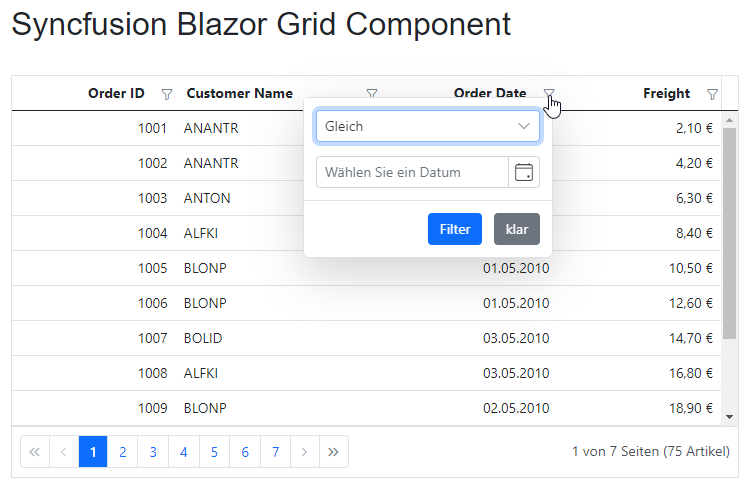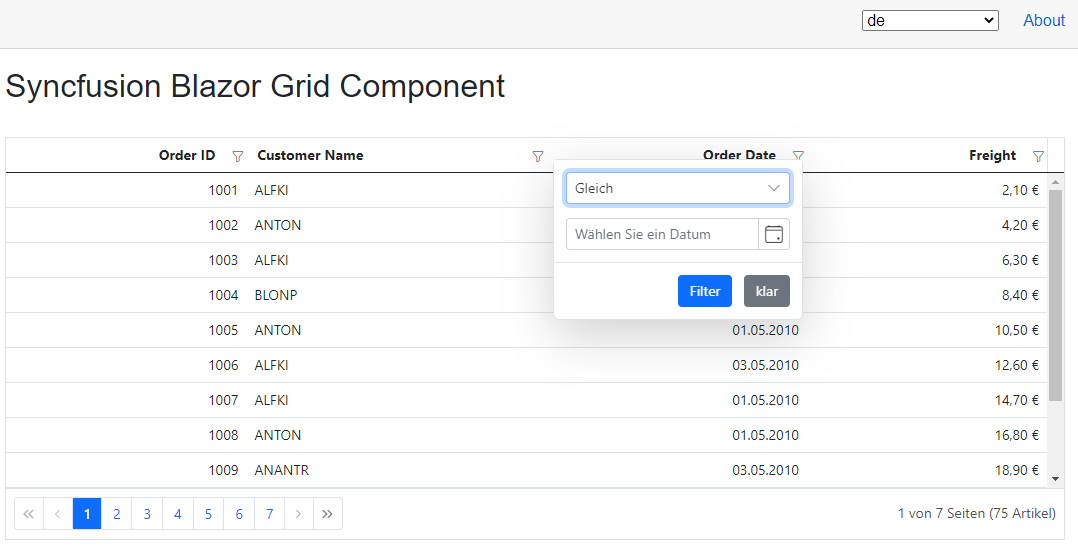Localization of Blazor Components
19 Nov 202522 minutes to read
Localization is the process of translating application resources into different languages for specific cultures. Syncfusion® Blazor components can be localized by adding a resource file for each language.
Localization of Syncfusion® Blazor Components
Use the following steps to localize Syncfusion® Blazor components based on culture. Example code is available in the repository below.
NOTE
Adding culture-based .resx files
Syncfusion® components can be localized using Resource .resx files. Default and culture-specific localization files are available in the following GitHub repository.
NOTE
Download default and culture-based resource files from GitHub.
Copy the default .resx file (SfResources.resx) and any required culture-specific .resx files to the Resources folder. For a .NET MAUI Blazor app, create a LocalizationResources folder and add them there.

NOTE
Update the localization files whenever upgrading Syncfusion® NuGet packages to prevent mismatches in localization strings.
After adding the resource files, open the default resource file (SfResources.resx) in the Resource Editor and set Access Modifier to Public.

Create and register localization service
ISyncfusionStringLocalizer acts as middleware between Syncfusion® Blazor UI components and resource files and uses the ResourceManager to provide culture-specific resources at runtime. Create a class that implements ISyncfusionStringLocalizer. In the class, return the ResourceManager created in the previous step for the ResourceManager property and update GetText to return the localized string.
In the following code, the SyncfusionLocalizer class implements the ISyncfusionStringLocalizer interface, and the ResourceManager is configured to return the cached ResourceManager instance of the default resource file created in the “Adding culture-based .resx files” step.
using Syncfusion.Blazor;
public class SyncfusionLocalizer : ISyncfusionStringLocalizer
{
public string GetText(string key)
{
return this.ResourceManager.GetString(key);
}
public System.Resources.ResourceManager ResourceManager
{
get
{
// Replace the ApplicationNamespace with your application name.
return ApplicationNamespace.Resources.SfResources.ResourceManager;
//For .Net Maui Blazor App
// Replace the ApplicationNamespace with your application name.
//return ApplicationNamespace.LocalizationResources.SfResources.ResourceManager;
}
}
}Register ISyncfusionStringLocalizer and the Syncfusion® Blazor service in the ~/Program.cs file of your app.
- For a Blazor Web App using an Interactive render mode (WebAssembly or Auto), register
SyncfusionLocalizerand the Syncfusion® Blazor services in both Server and Client~/Program.csfiles. - For a .NET MAUI Blazor app, register the Syncfusion® Blazor service in ~/MauiProgram.cs.
using Syncfusion.Blazor;
...
builder.Services.AddSyncfusionBlazor();
// Register the locale service to localize the SyncfusionBlazor components.
builder.Services.AddSingleton(typeof(ISyncfusionStringLocalizer), typeof(SyncfusionLocalizer));
...Statically set the culture
If culture changes are not required at runtime, set the culture statically using the options below.
Blazor Web App and Blazor WASM App
In Blazor Web App and Blazor WebAssembly (WASM) apps, set culture either in Blazor’s start options or in C# code.
Setting the culture in Blazor’s start option
Set the app’s culture in JavaScript by configuring applicationCulture in Blazor’s start options:
- For .NET 8, .NET 9 and .NET 10 Blazor Web Apps using any render mode (Server, WebAssembly, or Auto), prevent Blazor autostart by adding
autostart="false"to the Blazor<script>tag in ~/Components/App.razor. - For a
Blazor WebAssembly Standalone app, prevent Blazor autostart by addingautostart="false"to the Blazor<script>tag in wwwroot/index.html.
<body>
...
<script src="_framework/blazor.web.js" autostart="false"></script>
...
</body><body>
...
<script src="_framework/blazor.webassembly.js" autostart="false"></script>
...
</body>- Add the script block below the Blazor
<script>tag and before the closing </body> tag to start Blazor with a specific culture.
<body>
...
<script src="_framework/blazor.web.js" autostart="false"></script>
<script>
Blazor.start({
webAssembly: {
applicationCulture: 'de'
}
});
</script>
...
</body><body>
...
<script src="_framework/blazor.webassembly.js" autostart="false"></script>
<script>
Blazor.start({
applicationCulture: 'de'
});
</script>
...
</body>Setting the culture in C# code
For Blazor Web App and Blazor WASM apps, set culture in C# as an alternative to Blazor’s start option. Set CultureInfo.DefaultThreadCurrentCulture and CultureInfo.DefaultThreadCurrentUICulture in Program.cs to the same culture before the call that builds and runs the WebAssemblyHostBuilder (await builder.Build().RunAsync();).
using System.Globalization;
CultureInfo.DefaultThreadCurrentCulture = new CultureInfo("de-DE");
CultureInfo.DefaultThreadCurrentUICulture = new CultureInfo("de-DE");MAUI Blazor App
In a .NET MAUI Blazor app, set culture in C# by configuring CultureInfo.DefaultThreadCurrentCulture and CultureInfo.DefaultThreadCurrentUICulture in MauiProgram.cs to the same culture. Ensure this configuration occurs before returning from MauiApp.CreateBuilder() (that is, before return builder.Build();).
using System.Globalization;
CultureInfo.DefaultThreadCurrentCulture = new CultureInfo("de-DE");
CultureInfo.DefaultThreadCurrentUICulture = new CultureInfo("de-DE");
Dynamically set the culture
Set culture dynamically based on user preference. The following example uses a localization cookie or local storage to persist the user’s selection.
Blazor Web App and Blazor Standalone WASM App
For Blazor Web App and Blazor WASM Standalone apps, set the BlazorWebAssemblyLoadAllGlobalizationData property to true in the project file:
<PropertyGroup>
<BlazorWebAssemblyLoadAllGlobalizationData>true</BlazorWebAssemblyLoadAllGlobalizationData>
</PropertyGroup>- For .NET 8, .NET 9 and .NET 10 Blazor Web Apps using any render mode (Server, WebAssembly, or Auto), add JavaScript in ~/Components/App.razor (after the Blazor
<script>tag and before</body>) to get and set the user’s selected culture in browser local storage. - For a Blazor WASM Standalone app, add the JavaScript in wwwroot/index.html (after the Blazor
<script>tag and before</body>).
<script src="_framework/blazor.web.js"></script>
<script>
window.cultureInfo = {
get: () => window.localStorage['BlazorCulture'],
set: (value) => window.localStorage['BlazorCulture'] = value
};
</script>
<script src="_framework/blazor.webassembly.js"></script>
<script>
window.cultureInfo = {
get: () => window.localStorage['BlazorCulture'],
set: (value) => window.localStorage['BlazorCulture'] = value
};
</script>
In Program.cs, use JS interop to call the functions above and retrieve the user’s culture selection from local storage. If local storage doesn’t contain a culture, a default of United States English (en-US) is set.
For a Blazor Web App using an Interactive render mode (WebAssembly or Auto), register SyncfusionLocalizer and Syncfusion® Blazor services in both Server and Client ~/Program.cs files.
using Microsoft.JSInterop;
using System.Globalization;
...
builder.Services.AddSyncfusionBlazor();
//Register the Syncfusion locale service to localize Syncfusion Blazor components.
builder.Services.AddSingleton(typeof(ISyncfusionStringLocalizer), typeof(SyncfusionLocalizer));
var host = builder.Build();
//Setting culture of the application
var jsInterop = host.Services.GetRequiredService<IJSRuntime>();
var result = await jsInterop.InvokeAsync<string>("cultureInfo.get");
CultureInfo culture;
if (result != null)
{
culture = new CultureInfo(result);
}
else
{
culture = new CultureInfo("en-US");
await jsInterop.InvokeVoidAsync("cultureInfo.set", "en-US");
}
CultureInfo.DefaultThreadCurrentCulture = culture;
CultureInfo.DefaultThreadCurrentUICulture = culture;
await builder.Build().RunAsync();Create a CultureSwitcher component to store the user’s culture selection in browser local storage via JS interop and force a page reload to apply the updated culture.
@using System.Globalization
@inject IJSRuntime JSRuntime
@inject NavigationManager NavigationManager
<select @bind="Culture">
@foreach (var culture in supportedCultures)
{
<option value="@culture">@culture.DisplayName</option>
}
</select>
@code {
private CultureInfo[] supportedCultures = new[]
{
new CultureInfo("en-US"),
new CultureInfo("de-DE"),
new CultureInfo("fr-FR"),
new CultureInfo("ar-AE"),
new CultureInfo("zh-HK")
};
private CultureInfo Culture
{
get => CultureInfo.CurrentCulture;
set
{
if (CultureInfo.CurrentCulture != value)
{
var js = (IJSInProcessRuntime)JSRuntime;
js.InvokeVoid("cultureInfo.set", value.Name);
NavigationManager.NavigateTo(NavigationManager.Uri, forceLoad: true);
}
}
}
}Add the CultureSwitcher component to ~/MainLayout.razor to enable the culture switcher on all pages. For a Blazor Web App with interactivity location set to Per page/component, specify a render mode on the CultureSwitcher component instance in ~/MainLayout.razor.
<div class="page">
....
<main>
<div class="top-row px-4">
<CultureSwitcher @rendermode="@InteractiveAuto" />
....
</div>
</main>
</div><div class="page">
....
<main>
<div class="top-row px-4">
<CultureSwitcher />
<a href="https://docs.microsoft.com/aspnet/" target="_blank">About</a>
</div>
</main>
</div>Blazor Server App and Blazor Web App (Interactive Server)
Configure supported cultures and ensure the app processes controller actions by calling AddControllers and MapControllers.
For a Blazor Web App using the Interactive render mode of Server, register SyncfusionLocalizer and Syncfusion® Blazor services in the ~/Program.cs files.
builder.Services.AddControllers();
builder.Services.AddSyncfusionBlazor();
builder.Services.AddLocalization();
var supportedCultures = new[] { "en-US", "de-DE", "fr-FR", "ar-AE", "zh-HK" };
var localizationOptions = new RequestLocalizationOptions()
.SetDefaultCulture(supportedCultures[0])
.AddSupportedCultures(supportedCultures)
.AddSupportedUICultures(supportedCultures);
var app = builder.Build();
app.UseRequestLocalization(localizationOptions);
// Configure the HTTP request pipeline.
if (!app.Environment.IsDevelopment())
{
app.UseExceptionHandler("/Error");
// The default HSTS value is 30 days. You may want to change this for production scenarios, see https://aka.ms/aspnetcore-hsts.
app.UseHsts();
}
app.UseHttpsRedirection();
app.UseStaticFiles();
app.UseRouting();
app.MapControllers();
app.MapBlazorHub();
app.MapFallbackToPage("/_Host");
app.Run();For .NET 10, .NET 9 and .NET 8, set the current culture in a cookie in the App component file.
@using System.Globalization
@using Microsoft.AspNetCore.Localization
@code {
[CascadingParameter]
public HttpContext? HttpContext { get; set; }
protected override void OnInitialized()
{
HttpContext?.Response.Cookies.Append(
CookieRequestCultureProvider.DefaultCookieName,
CookieRequestCultureProvider.MakeCookieValue(
new RequestCulture(
CultureInfo.CurrentCulture,
CultureInfo.CurrentUICulture)));
}
}Provide a UI to allow the user to select a culture using a redirect-based approach with a localization cookie. The controller sets the user’s selected culture into a cookie and redirects back to the original URI.
using Microsoft.AspNetCore.Localization;
using Microsoft.AspNetCore.Mvc;
[Route("[controller]/[action]")]
public class CultureController : Controller
{
public IActionResult SetCulture(string culture, string redirectUri)
{
if (culture != null)
{
HttpContext.Response.Cookies.Append(
CookieRequestCultureProvider.DefaultCookieName,
CookieRequestCultureProvider.MakeCookieValue(
new RequestCulture(culture)));
}
return LocalRedirect(redirectUri);
}
}Create a CultureSwitcher component and place it inside the shared folder to perform the initial redirection when the user selects a culture.
@using System.Globalization
@inject NavigationManager NavigationManager
@inject HttpClient Http
<p>
<label>
Select your locale:
<select @bind="Culture">
@foreach (var culture in supportedCultures)
{
<option value="@culture">@culture.DisplayName</option>
}
</select>
</label>
</p>
@code {
private CultureInfo[] supportedCultures = new[]
{
new CultureInfo("en-US"),
new CultureInfo("de-DE"),
new CultureInfo("fr-FR"),
new CultureInfo("ar-AE"),
new CultureInfo("zh-HK")
};
protected override void OnInitialized()
{
Culture = CultureInfo.CurrentCulture;
}
private CultureInfo Culture
{
get => CultureInfo.CurrentCulture;
set
{
if (CultureInfo.CurrentCulture != value)
{
var uri = new Uri(NavigationManager.Uri)
.GetComponents(UriComponents.PathAndQuery, UriFormat.Unescaped);
var cultureEscaped = Uri.EscapeDataString(value.Name);
var uriEscaped = Uri.EscapeDataString(uri);
NavigationManager.NavigateTo(
$"Culture/SetCulture?culture={cultureEscaped}&redirectUri={uriEscaped}",
forceLoad: true);
}
}
}
}Add the CultureSwitcher component to Shared/MainLayout.razor to enable the culture switcher on all pages.
<div class="page">
<div class="sidebar">
<NavMenu />
</div>
<main>
<div class="top-row px-4">
<CultureSwitcher></CultureSwitcher>
<a href="https://learn.microsoft.com/aspnet/core/" target="_blank">About</a>
</div>
<article class="content px-4">
@Body
</article>
</main>
</div>MAUI Blazor App
In App.xaml.cs, use Preferences to retrieve the user’s stored culture selection. If storage doesn’t contain a culture, default to United States English (en-US).
using System.Globalization;
namespace LocalizationMauiBlazor
{
public partial class App : Application
{
public App()
{
InitializeComponent();
var language = Preferences.Get("language", "en-US");
var culture = new CultureInfo(language);
CultureInfo.DefaultThreadCurrentCulture = culture;
CultureInfo.DefaultThreadCurrentUICulture = culture;
MainPage = new MainPage();
}
}
}Create a CultureSwitcher component to store the user’s culture selection via Preferences and force a page reload to apply the updated culture.
@using System.Globalization
@inject NavigationManager NavigationManager
<select @bind="Culture">
@foreach (var culture in supportedCultures)
{
<option value="@culture">@culture.DisplayName</option>
}
</select>
@code {
private CultureInfo[] supportedCultures = new[]
{
new CultureInfo("en-US"),
new CultureInfo("de-DE"),
new CultureInfo("fr-FR"),
new CultureInfo("ar-AE"),
new CultureInfo("zh-HK")
};
private CultureInfo Culture
{
get => CultureInfo.CurrentCulture;
set
{
if (CultureInfo.CurrentCulture != value)
{
CultureInfo.DefaultThreadCurrentCulture = value;
CultureInfo.DefaultThreadCurrentUICulture = value;
Preferences.Set("language", value.Name);
NavigationManager.NavigateTo(NavigationManager.Uri, forceLoad: true);
}
}
}
}Add the CultureSwitcher component to Layout/MainLayout.razor to enable the culture switcher on all pages.
@inherits LayoutComponentBase
<div class="page">
<div class="sidebar">
<NavMenu />
</div>
<main>
<div class="top-row px-4">
<a href="https://learn.microsoft.com/aspnet/core/" target="_blank">About</a>
</div>
<article class="content px-4">
<CultureSwitcher />
@Body
</article>
</main>
</div>
NOTE